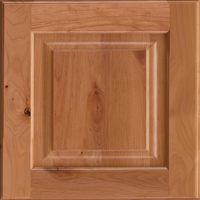The natural characteristics of the wood you choose for your cabinets will have a significant effect on the look and feel of your room. When choosing your wood, there are three important factors to keep in mind: grain, color and type.
Grain
Like a fingerprint, a wood’s grain refers to its overall alignment, texture and natural patterning. Each tree has its own distinct grain markings and patterns, making each piece of wood from that tree unique. Learn more about grain types.
Color
Each wood is consistently similar in color and all will have natural color variations, many of which will occur within the same tree. These variations create an endless array of unique and beautiful possibilities for your cabinets and may become more pronounced after a finish is applied. Your choice of finishing techniques can either enrich or obscure the wood’s natural markings, so it’s important to understand the characteristics of the various wood choices to ensure you select the right wood and finish for your room.
Type
Wood choice is crucial in helping you create that special look and feel for your room. There are two types of wood: softwood and hardwood. Some examples of softwood include ash, spruce, cedar and pine. Marble Today cabinets are traditionally made from hardwoods, which are described below:

Alder
Softer than most other hardwoods, Alder may have a fine or straight grain pattern. Its color can range from light brown to tan, which may also bear reddish undertones. Some of the more common and anticipated characteristics of Alder are burls, knots, worm holes and mineral streaks, all of which enhance the wood’s inherent natural beauty.

Birch
A smooth, light-colored hardwood, Birch may display a straight, wavy or curly grain. It stains well and typically varies from cream to light yellow, but may show signs of a darker red or brown near the heartwood. These variations make it very versatile and allow you to project many looks ranging from casual to a more refined feel.

Cherry
A warm, luxurious wood with a smooth, tight grain, Cherry ranges in color from white to a deep, reddish-brown. Because of its unique photosensitivity, Cherry’s color also tends to mellow and darken with age. This process may be enhanced by exposure to bright light, and the color may deepen several shades over time. Cherry cabinets project a warm elegance in any room.

Hickory
A strong, heavy hardwood, Hickory displays many natural random streaks that create a unique look and feel. Light or natural stains tend to enhance its array of inherently prominent colors, which range from light cream to dark brown to nearly black in some cases.

Maple
A medium-to-hard hardwood, Maple may display a straight, wavy or curly grain. It is admired for its durability and strength and often bears a light, uniform appearance that stains well. It may also be finished to mock more expensive woods, such as Cedar and Cherry. From a light, casual appearance to a dark, dramatic feel, Maple cabinets make a lasting statement.

Oak
A sturdy, heavy hardwood, Oak typically displays a rather coarse grain that varies from a straight to a more arching pattern. Oak can be either naturally red or white in hue and it stains nicely. It is widely popular, as it blends perfectly with many different looks and projects a timeless style and beauty.
